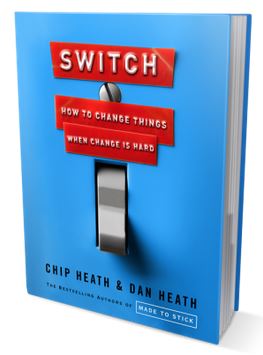Let’s face it, change is hard. I know that you’ve tried to change what you eat or started a new exercise program and it just didn’t work. But here’s the kicker, if you want to be healthier, eating real food and exercising are incredibly important.
So, you might ask, how do you go about changing what you eat or how much exercise you do when you already have ingrained habits?
As an Integrative RDN (Registered Dietitian Nutritionist), I do a lot of reading and one area that I’m fascinated by is “change psychology”. Every day, I help clients make changes to what they eat, their exercise patterns, and more specifically, their behaviors. I just finished reading Switch: How to Change Things When Change Is Hard by Chip and Dan Heath. The book was fantastic. It laid out why change is hard and how to make it easier. If you want to geek-out and read it, I’d highly recommend it. If not, here are three insights from the book that will help you make changes in your life.
Insight #1: The Elephant and the Rider
This analogy was a powerful theme throughout the book. The elephant represents your emotional side and the rider represents your rational or mental side. Picture an enormous elephant with a person riding on its back. The rider can try to steer the elephant to where he wants to go, but unless the elephant wants to go in that direction too, its a lost cause. In order to be successful in making a change, you have to very specifically tell the rational side (rider) where to go and what to do, and motivate the emotional side (elephant) by finding the feeling that makes you want to do something and shrink the change enough that it isn’t so scary.
Insight #2: Shape the Path
Sometimes all it takes to make a change is to modify your environment. For example, if the change you want to make is to stop eating chips, don’t buy them (and ask people in your house very kindly to support you by not buying them). If you don’t have chips in your house, you can’t eat them. Sometimes, making changes really IS as simple as that. No motivating the elephant or directing the rider necessary; simply changing the environment forces you to change your behavior.
Insight #3: Set an Action Trigger
When you want to make a change, set an “action trigger”. To do this, simply imagine the time and place where you’re going to act differently. For example, if you want to start going to the gym on Monday, Wednesday, and Friday, imagine where you’re going to go, what time you’re going to go, how you’re going to get there, and what you’re going to do when you’re there. By simply imagining the logistics about your change, it will be much easier to execute the change when the time comes.
I’ve shared three insights from the book Switch. How can you apply one of these (or all three) to help you make changes to improve your nutrition or fitness? Share your thoughts by leaving a comment below.

